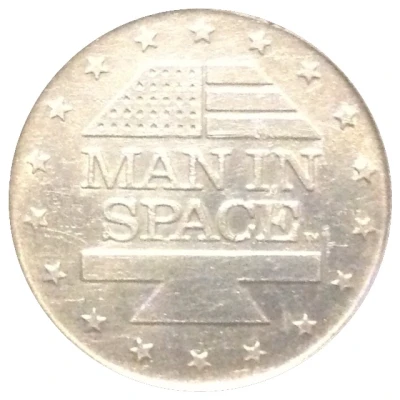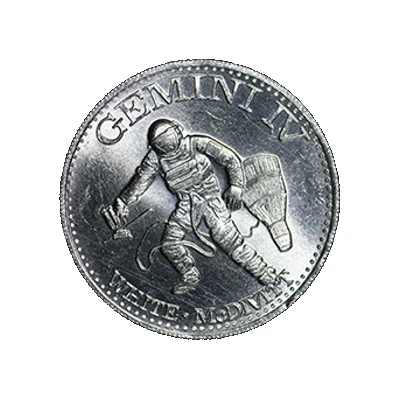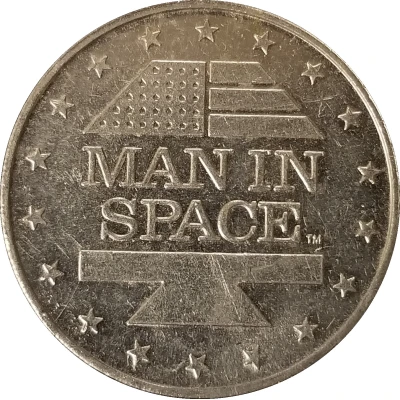


© MYEACKLE (CC BY)
Shell Oil Token - Man In Space Gemini IX ND
1969 year| Aluminium | 1.7 g | 26 mm |
| Location | United States |
|---|---|
| Type | Medals › Advertising medallions |
| Year | 1969 |
| Composition | Aluminium |
| Weight | 1.7 g |
| Diameter | 26 mm |
| Thickness | 1 mm |
| Shape | Round |
| Technique | Milled |
| Orientation | Medal alignment ↑↑ |
| Updated | 2024-11-13 |
| Numista | N#73772 |
|---|---|
| Rarity index | 91% |
Reverse
Stylized United States Flag.
Script: Latin
Lettering:
MAN IN
SPACE
Edge
Reeded
Comment
"Man In Space" "Commemorating US Manned Space Missions".http://www.billjamie.com/Shell/Shell-Coin-Game/Man-In-Space/Man-In-Space.html
Man In Space was a promotional game issued by the Shell Oil Company in 1969. This was a collect-and-win game with instant winners. With each visit to a participating Shell station, customers received a free aluminum game 'coin' commemorating a U. S. manned space mission. Twenty-six different Man In Space coins were issued. The coins could be mounted on a game card (also free). If all the coins in a section of the game card could be collected, the player won the prize for that section.
Prizes included cash in the amounts of $1, $5, $50, $500 and $5,000. Players could also win a beautiful set of bronze space medals which came with a mounting board and an informative booklet about the space missions.
If a game coin had INSTANT WINNER on the back, a prize was won without having to collect any other coins. The instant winner prizes were listed on the game card.
Glendinning Companies, Inc. produced the game pieces, game prizes, and all the associated promotional materials. Glendinning used their newly-created subsidiary, The Danbury Mint, to strike the medallions and medals.
The game 'coins' (more accurately, 'medallions') were made of aluminum, 26mm in diameter with a reeded edge. They were packaged in plastic capsules with a paper cover. The capsules were designed so the coin hidden inside could be pushed through the paper cover to be removed.
Three reverse designs were used on the game coins. Over 98% of the coins were minted with the common design. Less than 2% of all the coins were key, prize-winning coins and they were minted (in roughly equal quantities) with either the 'Instant Winner' reverse design, or a modified version of the common design. The modified reverse design is the same as the common design except the 'P' in 'SPACE' is filled in.**
There are two varieties of the 'key' coins for each of the six prize sections (except the top prize). This resulted in eleven different 'key' prize-winning coins. Combined with the fifteen common coins, a total of twenty-six different aluminum coins were issued in this game. The following table lists the prize-winning coins.
The top prize in the game was $5,000 cash. That was a lot in 1969; enough to buy a new Corvette (or two Chevy Novas)! There were also cash prizes of $500, $50, $5 and $1.
In addition to cash, players could win a beautiful set of commemorative space medals struck in bronze. The set came in a large envelope which included the medals, a cardboard mounting board for the medals, and an informative booklet about the space missions depicted on the medals. On the reverse of each medal was a short description of the space mission.
There are two versions of this prize. The original version included twenty-one bronze medals. The designs corresponded to the twenty-one obverse designs on the aluminum game coins. In fact, both the bronze medals and the aluminum game coins were struck with the exact same dies. The medals and game coins were struck by The Danbury Mint.
On November 24, 1969, Apollo XII successfully completed their moon landing mission and splashed down in the Pacific. The Danbury Mint then created a twenty-second medal commemorating this mission and added it to the set. Therefore, all the bronze prize sets contained twenty-two medals starting in December, 1969. No Apollo XII game coins were struck in aluminum.



